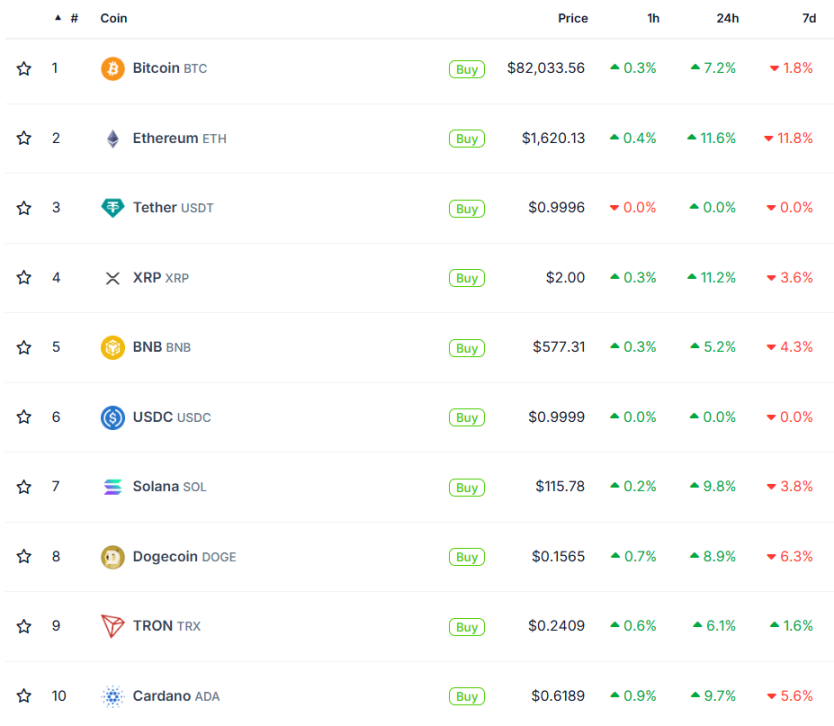Written by: Pzai, Foresight News
The market is surging with Trump's banner waving.
On April 9, as Trump announced a 90-day pause on tariffs for other countries and reduced reciprocal tariffs to 10%, the crypto market quickly responded, with mainstream assets generally rising. Meanwhile, with the U.S. Senate approving Paul Atkins as SEC Chairman and CFTC Acting Chair Caroline D. Pham stating that they will no longer file lawsuits for digital asset registration violations, the future of the U.S. crypto market is becoming clearer.
Market Sentiment Overview
For mainstream assets, the top ten assets rose by over 5% in a single day, partially recovering from the week's decline. Bitcoin recovered to the $82,000 level, while Ethereum returned above $1,600. Although Trump's tariff stick continues to wave, it remains unclear which countries are exactly exempted from tariffs and whether Trump still plans to significantly escalate the trade war. However, crypto assets benefited from the "trade war cooling" expectation, coupled with regulatory relaxation, and the short-term positive sentiment has effectively restored the market from its previous mood.

In such a volatile market, according to Coinglass data, the network liquidated $477 million in the past 24 hours, with long positions liquidating $130 million and short positions liquidating $347 million. Among these, Bitcoin liquidated $180 million, and Ethereum liquidated $135 million. In this market environment, Bitwise CIO Matt Hougan stated, "Bitcoin bulls should be inspired by its performance... Once market volatility stabilizes, we will see it return to new historical highs or even higher."

Tariff Suspension Expectation Lands, What Are Market Views?
After the tariff delay, many possibilities are emerging. In the macro environment, the market originally expected the Federal Reserve might start cutting rates in the second half of 2025, but Fed analysts predict that if the tariff pause continues, the inflation impact will weaken, and the threshold for rate cuts remains high. If Trump extends the tariff pause for 90 days or announces tariff exemptions for more countries (such as Europe, Japan, and South Korea), it will further reduce global trade friction pressure, coupled with regulatory relaxation and capital inflow expectations, helping the crypto market maintain its strength. After China's reciprocal tariff countermeasures, Trump explicitly stated he would impose tariffs on Chinese goods up to 125%, and the potential impact of a new round of China-U.S. trade friction is causing global risk aversion to rise. The corresponding rise in global risk aversion will be unfavorable to risk assets, including cryptocurrencies, in the short term.
Most analyses believe that if the tariff pause can significantly alleviate imported inflation pressure, the Federal Reserve may relatively delay its rate-cutting pace in the medium to long term. On the other hand, if global trade friction continues or escalates, risk assets will face more downward pressure in the short term, and the Federal Reserve may be caught in a more complex trade-off in monetary policy. Considering the internal disagreements in the U.S. regarding tariff policies, the probability of future policy reversals is high, and market sentiment may fluctuate accordingly. The market will need to pay more attention to the Federal Reserve's monetary policy direction (especially the FOMC meetings in June and September). If market expectations gradually adjust to "loose to neutral," the crypto market may continue its recent warming trend; conversely, if the situation worsens and the Federal Reserve becomes more hawkish, the pressure on risk assets could quickly accumulate.
Multiple Institutions Collaboratively Promote Compliance, Crypto Stocks Rebound Strongly
While the market fluctuates, the compliance progress of the U.S. crypto market continues to advance steadily.
On April 8, according to Fortune magazine, U.S. Deputy Attorney General Todd Blanche instructed the immediate closure of the Justice Department's crypto litigation department (NCET), which was established in 2021 and handled several milestone cases, including the crypto mixer Tornado Cash and Mango Markets vulnerability incident. Blanche stated that the previous administration used the Justice Department with a "reckless strategy" by over-regulating the crypto industry through enforcement actions. On the same day, CFTC Acting Chair Caroline D. Pham also agreed with the Justice Department's policy, stating that they will no longer file lawsuits for digital asset registration violations and launch a plan to quickly resolve accumulated non-compliance issues. These compliance advances, coupled with Trump's tariff policy benefits, drove crypto stocks to rebound on April 9. MSTR recovered to near $300, closing at $296.86, with a single-day increase of 24.76%.

At the Senate Banking Committee hearing in March 2025, new SEC Chairman Paul Atkins stated in his testimony that he will prioritize creating a regulatory framework for digital assets, emphasizing the urgency of establishing clear digital asset rules, with momentum building for bills like FIT 21. Although bipartisan progress has been made, some Democrats criticize the Justice Department for abandoning crypto enforcement and express concerns about who will regulate the field and whether outdated legal frameworks are still applicable. When regulatory policies become clear and coherent, market uncertainty will significantly decrease. Recent compliance dynamics signal that U.S. regulators are actively building a long-term management mechanism for crypto assets. This helps reduce volatility risks for investors who have long focused on compliance and regulation, and companies that have faced high compliance costs and legal risks in the industry may gain more development space in the future.
In the era of Trump's continued deep involvement in crypto, this series of regulatory relaxation is not isolated but a key piece of the American "crypto national strategy" - the Justice Department's withdrawal to reduce industry burden, CFTC's flexible enforcement to expand market base, and SEC's rule-making to attract mainstream funds. The integration and cooperation of these departments reflect the U.S. attempt to build a crypto market system of "regulatory friendliness - market size - strategic reserves". As this system further deepens, we have reason to believe that the crypto market is gradually entering more investors.








